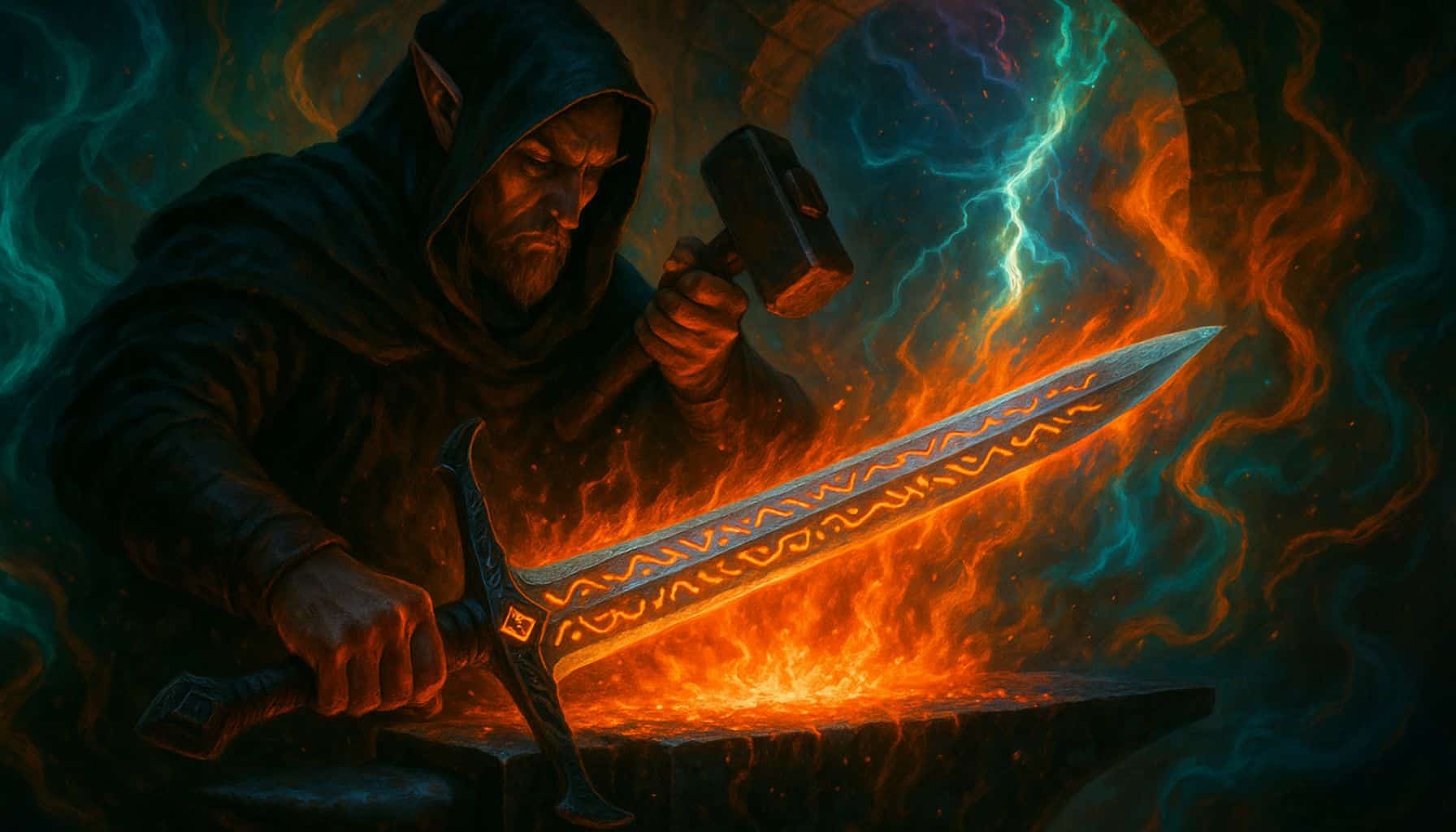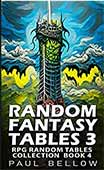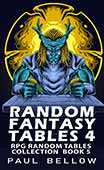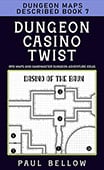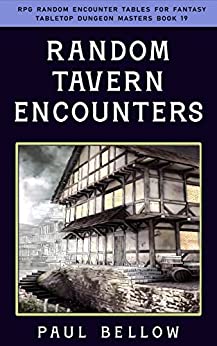Every Dungeons & Dragons group eventually daydreams about that one weapon—the legendary blade, the unbreakable hammer, the staff brimming with untold sorcery—that could tip the scales in epic fashion. The allure of overpowered (OP) weapons is woven into the DNA of tabletop roleplaying, conjuring visions of grand battles, heroic deeds, and tales retold around the campfire. But seasoned Dungeon Masters know that crafting such powerful items is a delicate dance, requiring both narrative finesse and cool-headed game sense. These artifacts aren’t mere instruments of destruction; they’re tools for elevating the entire campaign experience.
Yet, mention “overpowered” to a table of DMs and you’ll see knowing smiles, wary eyes, perhaps a shiver or two. There’s a reason these weapons are rarely handed out like candy: OP weapons can wreck a game’s careful balance, steamroll tension, and turn collaborative storytelling into a numbers game. Some Dungeon Masters avoid them entirely, wary of the chaos they can unleash. The fear is real—what begins as fun can quickly spiral into a slog if one player dominates every encounter, or if epic threats become laughably trivial.
But what if OP weapons could be more than balance-breaking headaches? What if, with the right approach, they could spark awe, drive the narrative, and serve as hard-fought rewards for landmark achievements? Used judiciously, these mythic implements can inject campaigns with unforgettable peaks, dazzling challenges, and legendary legacies. Overpowered doesn’t have to mean broken; it can mean memorable, especially if you’re using the right magic item generator with AI!
In the end, the secret to wielding overpowered weapons isn’t about raw numbers or punitive limitations. It’s about timing, context, and intentionality. This guide will explore how, why, and when to introduce these dramatic artifacts without blowing up your campaign. Whether you’re a cautious DM or an adventurous player, you’ll find strategies for elevating your stories with power—without losing the heart of the game.
What Makes a Weapon Overpowered?
To pinpoint what makes a weapon truly overpowered, you first have to examine its foundation. An OP weapon does more than deal massive damage numbers; it bends the contours of the game. Think of weapons with abilities that manipulate the action economy—letting a wielder strike twice, cast a spell as a bonus action, or ignore the usual rules that reign in other equipment. The raw stats are only half the story. True OP comes from the blend of numbers and utility, the ways a weapon lets its wielder sidestep danger or change the story’s trajectory.
Mechanical power is the most obvious culprit. These weapons might offer absurdly high damage outputs, deal irresistible damage types, or grant exclusive access to spells well above the wielder’s pay grade. Some unlock synergies with specific builds: a melee weapon that lets a bard cast spells on a hit, or a dagger that empowers rogue sneak attacks beyond the usual cap. Such synergies can leapfrog class boundaries, rewriting not only the wielder’s strengths but the party’s tactics as a whole.
Try my AI Tabletop RPG generators...and an extensive library of content!
But narrative power is just as important, though harder to quantify. OP weapons are often steeped in lore, carrying reputations that echo through the campaign world. Possessing one might make kings wary, villains desperate, or monsters reckless. A sword fabled to slay dragons in a single stroke becomes more than a stat block—it warps the social and emotional stakes around it, ensuring every battle featuring the weapon feels high-drama.
Finally, overpowered status is not objective; it’s relative to your table. A sword that devastates goblins might be insignificant in a campaign of planar demigods, but in a gritty, mortal-scale adventure, it’s a world-ender. The tone of the campaign, party composition, and mutual expectations all play roles in defining what is truly “too much.” Ultimately, OP isn’t a label to fear—it’s a spectrum, and used wisely, it can supercharge the story without unbalancing play.
| Weapon Name | Core Ability Making it OP | Balance Concerns | Ideal Campaign Style |
|---|---|---|---|
| Dragonsoul Blade | Doubled crit range, fire burst | Overshadows other party damage | High Fantasy, Epic Heroism |
| Staff of Eternity | Free spell slot restoration | Spellcasters dominate pacing | Arcane Mysteries, Mythic |
| Doomhammer | Resets failed saves on hit | Negates high-stakes mechanics | Dark Epic, Demon Wars |
| Nightshade Dagger | Guaranteed poison bypass | Insta-kill risk | Grimdark, Assassins’ Guilds |
| Bow of the Phoenix | Infinite explosive arrows | Area damage trivializes crowds | High Adventure, Elemental |
| Mirrorblade | Reflects spells at double power | Nullifies spellcasters | Political Intrigue, Magic War |
| Spear of the Void | Ignores magical resistance | End-boss creatures trivialized | Planar Odyssey, Cosmic Horror |
| Ascendant Greataxe | Extra attacks per round | Main class balance disruption | Heroic Fantasy, Barbarian |
| Shield of Ruin | Full damage reflection | Outright reverses tough battles | High Tension, Epic Finales |
| Sunfury Rapier | Blinds and stuns on crit | Shutdowns make enemies irrelevant | Swashbuckling, Fae Courts |
When to Introduce Overpowered Weapons
Timing is everything when unveiling an overpowered weapon in your D&D campaign. Handing one out at low levels is like giving a child a flamethrower; awe quickly turns to ashes. Early-game OP items risk flattening growth arcs and trivializing encounters, depriving players of the tension and satisfaction that comes from earning their power. The sense of progression—the heartbeat of D&D—can easily flatline when a “game-breaking” artifact lands in level three hands.
On the flip side, holding back until the campaign’s dying moments means you risk leaving your players unsatisfied. An epic weapon should have room to breathe, to be wielded in triumph, and to see real action before the final curtain falls. Mid-to-late campaign introductions are usually ideal. Here, the party has paid their dues, and an OP weapon can feel like a deserved elevation. It’s the difference between receiving a family sword at the start of your journey and reforging it after you’ve become worthy.
⚔️ Fantasy RPG Random Tables Books
Make life as a Gamemaster easier…
If you play Dungeons & Dragons, Pathfinder, or other fantasy RPGs, this
RPG random tables series
is packed with encounters, NPCs, treasure, and more. Available in eBook or print—either way, you’ll have a wealth of adventure ideas at your fingertips.
Milestones are your secret allies. Unveil the weapon after a big boss fight, as the prize for a saga-spanning quest, or as the answer to a haunting personal backstory. Instead of just dropping it in a loot pile, tie its arrival to world-shaking events or triumphs that demand everything from your players. Want even more drama? Build entire arcs around unlocking, upgrading, or cleansing a weapon. Let attunement or mastery be a journey in itself, with narrative beats for every step.
Remember, OP arms make fantastic plot engines. Rival factions might pursue them. Ancient guardians may seek to reclaim them. A player’s relationship with the weapon can even become the focus of a narrative, shaping ambitions and alliances. Used this way, an overpowered weapon becomes both trophy and crucible—something the party cherishes, but must always defend, master, or redeem.
Smart Moments to Introduce OP Weapons
- Defeating a campaign’s primary villain
- Completing a divine or infernal trial
- Fulfilling a centuries-old prophecy
- Reclaiming a lost family heirloom
- Resolving a character’s central backstory mystery
- Winning a tournament held by gods or demigods
- Succeeding at a legendary side quest
- Achieving a world-altering milestone (e.g., freeing a kingdom)
- Discovering a weapon in a time-locked vault
- Making a bargain with a powerful entity
- Sacrificing greatly for a noble cause
- Surviving a near-death experience with the weapon’s spirit
- Repairing or reforging the weapon with rare components
- Uniting multiple artifact pieces into a single form
- Gaining favor from a patron deity or archfey
- Completing a campaign arc dedicated to “proving worthy”
- Saving the weapon’s original owner or its awakened spirit
- Solving a mythical riddle or puzzle tied to weapon history
Choose your moment wisely; a well-timed introduction makes the weapon feel earned, not handed out like a participation trophy.
A campaign’s greatest gifts are those that feel both hard-won and deeply entwined with the story’s fabric. Overpowered weapons should never be an afterthought or a bandage over a struggling plot. They are punctuation marks at the end of your campaign’s sentences—exclamation points that tell the table, “This moment matters.” When you time their arrival carefully, you guarantee your players remember not just what their characters wielded, but why it mattered so much.
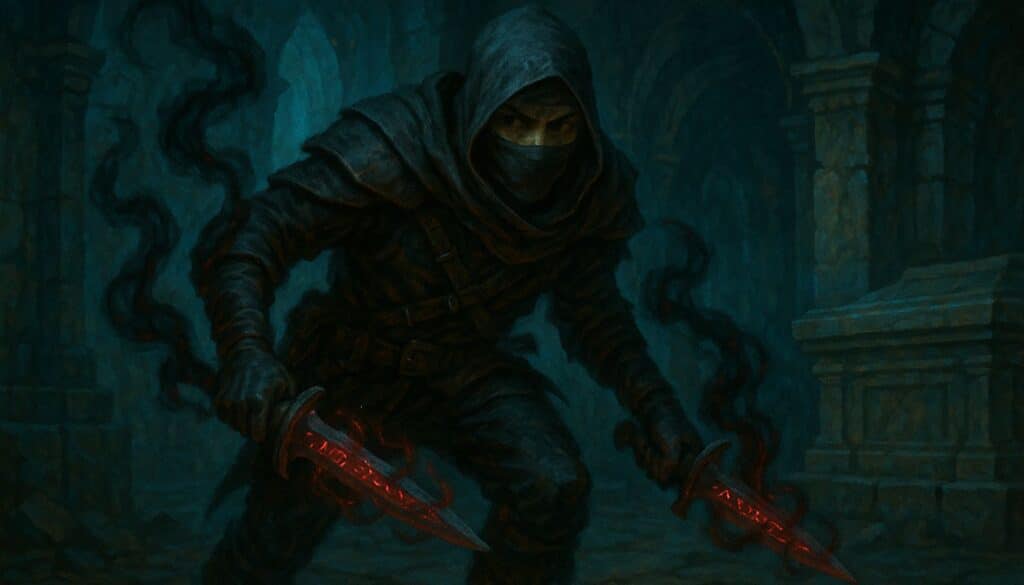
Crafting Overpowered Weapons from Scratch
Designing an original overpowered weapon isn’t about stacking ridiculous numbers onto a stat block. It begins with a name that evokes awe—something players whisper long after the dice stop rolling. A strong concept must be rooted in a story: who forged this relic, what wars has it witnessed, and why are its powers waking now? The weapon’s visual description should paint a vivid picture. Cloudstone halberds crackling with chained lightning, or rose-gold blades inscribed with ever-shifting runes—let the image be as compelling as its function.
Mechanically, you want more than “big damage.” Assign stats that tempt but don’t trivialize. Give the weapon unique abilities: maybe it stops time on a critical hit or lets the user call forth illusions that sway the course of battles. Don’t shy from attunement requirements or dramatic drawbacks—power should always come at a price. Perhaps the wielder absorbs some of the harm they inflict, or the weapon demands a heroic deed to unlock its final form. These restrictions turn mere loot into storytelling opportunities.
Draw inspiration generously. Pillage myth, legend, pop culture, and even your own players’ goals for ideas. The Sunblade gleams with Jedi energy; Excalibur promises sovereignty and sacrifice; even cloud-piercing anime swords find new life at the table. Let your players’ backgrounds and ambitions influence the weapon’s abilities or hidden purposes—it reinforces that this is their story, not just another dungeon crawl.
Most importantly, ensure the weapon fits your campaign’s vibe. A soul-devouring blade feels out of place in a light-hearted romp, while a harp that charms dragons might be right at home. Thematic consistency adds theatrical flair: set pieces, dramatic reveals, crystal-clear motives for why the weapon exists and what threats it was meant to face. The best OP weapons don’t just break the rules—they raise the stakes.
Features & Traits that Make Weapons Feel Overpowered
- Halting time on a critical hit (stunning everyone but the wielder)
- Ignoring all resistances and immunities
- Summoning allied minions or familiars at will
- Invoking reality-bending illusions or terrains
- Attacking through barriers or walls
- Absorbing spells and then redirecting them
- Dealing psychic or force damage on command
- Regenerating lost hit points from critical hits dealt
- Bypassing attunement—anyone can wield
- Transforming into other weapon forms
- Storing multiple spells for emergency casting
- Nullifying an environment’s hazardous effects
- Projecting an avatar or afterimage
- Absorbing the power of defeated rivals
- Enhancing all skill checks related to a certain theme (inspiration, fear, etc.)
- Drawing on lunar/solar energy for bonus effects
- Causing enemies to flee or surrender on a failed save
- Projecting a defensive barrier to protect the whole party
While it may be tempting to pile on ability after ability, resist the urge. Even the wildest artifact benefits from boundaries. Consider spreading powers across multiple party members or tying weapon upgrades to group accomplishments. This approach prevents resentment and encourages cooperation, turning the weapon’s story into one that unites rather than divides.
Ultimately, the mark of an unforgettable weapon isn’t its power, but how it changes the game for everyone involved. The best OP weapons serve as catalysts for teamwork, storytelling, and growth, rather than isolated spotlights on a single hero.
Balancing Overpowered Weapons Without Nerfing Fun
Introducing an overpowered weapon requires a DM’s steady hand—not as a surgeon, but as a composer, conducting experiences that keep everyone on their toes. Rather than simply dialing back damage or slapping on arbitrary restrictions, consider how each weapon fits into the rhythm of your campaign. Design encounters with clever enemies who learn, adapt, and devise new schemes. Monsters might possess resistances or exploit the wielder’s weaknesses, while recurring villains could seek to steal or nullify the weapon at crucial moments.
Think bigger than bland “more hit points.” Challenges may involve treacherous terrain—lava flows, collapsing bridges, or shifting magical fields—that even the mightiest sword can’t cleave through. Time-based effects ramp up the tension: perhaps the OP weapon’s true strength manifests only at night, on holy days, or after the wielder has suffered a grievous wound. By layering these elements, you create an environment where power feels thrilling but never routine.
⚔️ Fantasy RPG Random Tables Books
Make life as a Gamemaster easier…
If you play Dungeons & Dragons, Pathfinder, or other fantasy RPGs, this
RPG random tables series
is packed with encounters, NPCs, treasure, and more. Available in eBook or print—either way, you’ll have a wealth of adventure ideas at your fingertips.
Drawbacks and costs are your friends. Curses that sap the wielder’s luck, escalating attunement rituals, or mysterious voices whispering from the hilt all add weight. Maybe the weapon’s use alerts legendary foes, stains the wielder’s soul, or exacts a toll on the mind and spirit. These complications foster not just better gameplay balance, but also opportunities for character growth and dramatic conflict.
Above all, remember that balance need not mean restriction. Tension, risk, and personal investment are what drive fun. If the weapon’s presence sparks new rivalries, quests, or tough decisions, you’re doing it right. Sometimes, letting players wield shocking power is the start—not the end—of great storytelling.
Balancing Techniques for Overpowered Weapons
- Imposing a dangerous curse or drawback after major weapon use
- Escalating the attunement cost (sacrifices, quests, time spent)
- Introducing storyline consequences tied to weapon use
- Limiting abilities to certain conditions (full moon, blood oath, etc.)
- Weapon drawing attention from powerful rivals, authorities, or monsters
- Weakness to a specific creature type or energy
- Limited charges or daily uses for overpowered abilities
- The weapon’s abilities failing or faltering unpredictably
- Forcing the wielder to pass a saving throw or risk backfire
- Requiring dual attunement with an allied character
- Linking weapon power to party harmony (loses strength if party is at odds)
- Weapon’s true potential tied to a lingering quest or unfinished business
- Physical or mental exhaustion after prolonged use
Power must always feel earned, and tension is the secret ingredient that turns any reward into a story worth telling. Remind your players that even the most legendary artifacts have limits, and that mastering them is not just a matter of stats but of choices, sacrifices, and epic deeds.
Overpowered never means unstoppable. The drama lives in the moments where power teeters on the edge—when victory and calamity are both within reach.
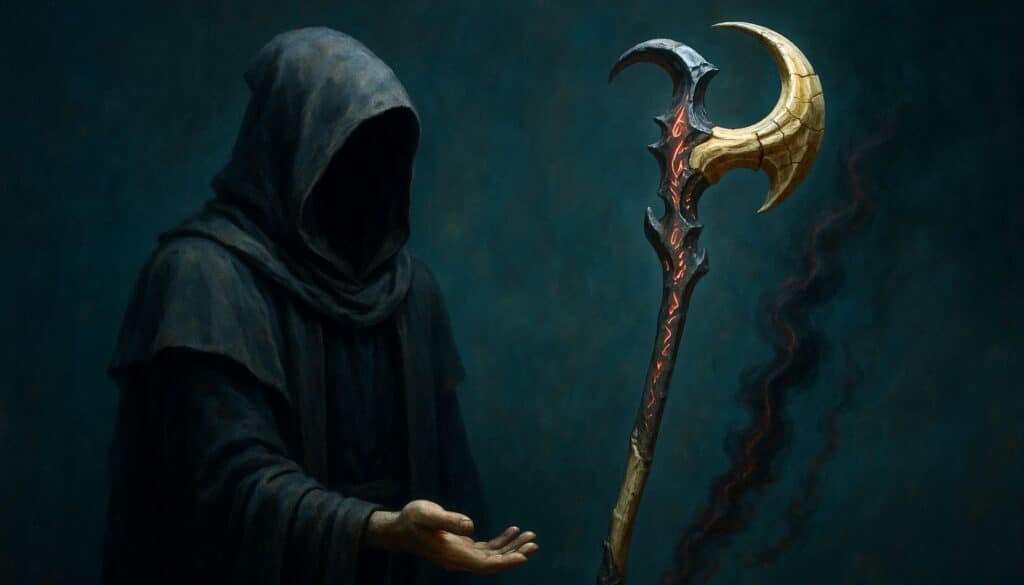
Legendary Weapons from Published Content
Some of the most memorable D&D weapons are sitting right in the official rulebooks, teasing players with their notorious reputations. The Vorpal Sword, with its infamous instant-decapitation potential, has haunted dungeon corridors for generations. The Staff of the Magi gleams as the ultimate spellcaster’s prize, tempting owners with spells, absorption powers, and even a self-destruct mechanism that can reshape destinies. Weapons like the Sword of Kas bring mythic weight into play, trailing both power and a legacy of betrayal in their steel.
These items don’t exist merely to pad out treasure lists—they bring with them legends that alter campaigns from the instant they appear. Their power isn’t just mechanical; it’s the story implications, the awe at the table, the sudden realization that the party has crossed a threshold into mythic play. Each artifact is meticulously balanced (or at least thoughtfully unbalanced) by countermeasures: curses that haunt users, destructive costs for their greatest powers, or enemies eager to claim the weapon for themselves.
When adapting these published weapons for your own campaign, you gain a template for greatness—but also for potential chaos. Consider tweaking their effects, tying their use to specific story beats, or introducing narrative costs that keep the item’s presence fresh and perilous. The magic isn’t in the stat block; it’s in how you weave these icons into your world’s ongoing narrative.
| Weapon Name | Book/Source | Why it Feels OP | How to Adapt or Rein In |
|---|---|---|---|
| Vorpal Sword | Dungeon Master’s Guide | Instant kill on critical hit | Limit decap effects to story foes |
| Staff of the Magi | Dungeon Master’s Guide | Spell absorption, multiple spellcasts | Reduce recharge, amplify drawback |
| Sword of Kas | Dungeon Master’s Guide | High damage, sentient evil power | Stronger curses, restrict attune |
| Blackrazor | Dungeon Master’s Guide | Absorbs souls, grants hit points | Enforce soul cost, time limits |
| Holy Avenger | Dungeon Master’s Guide | Massive bonuses, group buffs | Scale effects by party faith |
| Luck Blade | Dungeon Master’s Guide | Free wishes, crit boost | Wishes as quests, limit uses |
| Hammer of Thunderbolts | Dungeon Master’s Guide | Staggering damage, stun effect | More limited target list |
| Dagger of Venom | Dungeon Master’s Guide | Auto-poison, big sneak attack | Reduce poison DC, single use/day |
| Mace of Disruption | Dungeon Master’s Guide | Banishes undead, wish effects | Alternate effect on save |
| Sun Blade | Dungeon Master’s Guide | Extra radiant, advantage vs. undead | Bonus by campaign darkness level |
Overpowered Weapons and Player Psychology
Few things electrify a D&D player quite like picking up a sword rumored to split mountains or a staff said to warp time. Give a player an overpowered weapon and you’re handing them a rush of dopamine, a sense of achieved glory, and a new tool to define their character’s legacy. The emotional connection players develop with these items can easily rival their bonds with fellow characters. Weapons become totems—symbols of achievement, reminders of the battles won and the risks taken.
When a weapon is powerful, players treat it as more than just a tool. It becomes an extension of their character’s identity: the go-to solution for sticky situations, the centerpiece of combat descriptions, and often the object of in-jokes or table lore. This attachment can reshape player behavior, emboldening them to take risks or driving them to seek out greater challenges. The legend of the item and the legend of the character entwine, amplifying the campaign’s emotional stakes.
Try my AI Tabletop RPG generators...and an extensive library of content!
However, such power brings responsibility, both in- and out-of-game. Players who wield legendary artifacts often feel more visible—every action scrutinized by allies, enemies, and the world at large. They bear not just the weight of power but the consequences of their choices. This dynamic is a gift to the DM; harness it for drama, tension, and opportunities for personal growth, turning what could be a simple power boost into rich, ongoing character development.
Making Weapons Feel Personal
Transforming an overpowered weapon from a stat block into a living, breathing part of the campaign demands care and collaboration. Co-creating personal lore with your players infuses the item with history and weight. Was it forged by a forgotten ancestor, or woven from the desires of a dying deity? Is there a secret inscribed in the pattern of its grip, or a voice that whispers in dreams? By giving the weapon roots in a character’s backstory or tying it to overarching plot threads, you guarantee it will resonate far beyond battle.
Sentience is another path to investment, imbuing the weapon with quirks and motives all its own. Perhaps it craves glory, whispers advice, or falls silent when truths remain unspoken. Over time, let the weapon evolve alongside its wielder: unlocked forms, changing appearances, and new abilities reflecting the character’s triumphs, failures, or moral shifts. As the player grows, so too should the weapon, becoming a mirror for their journey.
Personalization options abound. Inscribe the family motto upon the blade. Weave its lore into dream sequences. Design encounters that only the weapon can resolve—or problems only it can cause. Let it react to the wielder’s alignment, transforming in appearance or ability when great decisions are made. Every added nuance sews another thread into the campaign’s tapestry, making the item unforgettable.
Ultimately, the mark of a truly personal weapon is that it’s not just something a character carries, but part of who they are. DMs should encourage players to imagine the item’s feel, weight, and voice, making it as much a narrative tool as a mechanical one. When the story rises and falls with that legendary relic, you’ve reached the heart of what makes D&D so utterly compelling.
Ways to Personalize OP Weapons
- Engraving the wielder’s family motto or crest
- Reacting to character alignment changes (glow, transform, etc.)
- Requiring dream-visions or quests to unlock full power
- Shifting form based on wielded intent (blade splits, shifts color, etc.)
- Developing a sentient personality with evolving goals
- Allowing it to “grow” or unlock new abilities over time
- Linking weapon to key party or world events
- Whimsically changing its name after each epic deed
- Sharing dreams, visions, or prophecies with the owner
- Behaving differently with different wielders (favoritism, jealousy, etc.)
- Binding to the wielder’s fate—surviving as long as they do
- Allowing players to narrate how powers manifest
- Weapon “requests” or “demands” influencing plot choices
- Morphing in appearance or powers during important moments
- Being an essential part of solving historical or magical puzzles
- Communicating through symbols, riddles, or songs
- Giving it specific goals or taboos it enforces dynamically
Remember, OP weapons are roleplay powerhouses, not just instruments of mayhem. Treating them as such elevates every session. The more the weapon is entangled with a player’s journey, the more your whole group will feel the campaign’s stakes and stories deepen.
A legendary weapon should never become just another line on a character sheet. Invest time, energy, and story into these artifacts, and watch as your players rise to meet the emotional and epical heights you’ve created together.
When to Retire or Remove Overpowered Weapons
Even the most storied weapons must eventually rest. A graceful exit for an overpowered relic is as important as its dramatic entrance. Sometimes the narrative simply demands it: perhaps the artifact has fulfilled its ancient purpose, completed the story it was born to tell, or chosen to pass into legend. Retiring a legendary weapon through moments of triumph or self-sacrifice lets the campaign end on a note of bittersweet heroism.
There are times when mechanics demand a reset. Maybe the weapon’s power flickers out beyond a certain plane, or it can only be wielded during specific cosmic alignments. Alternatively, the world itself may reject the presence of such a force, forcing the party to relinquish it lest greater calamity follow. Trade-in opportunities can also be satisfying, as players exchange the familiar relic for something new, shifting the party’s dynamic and keeping gameplay fresh.
The trick is to avoid cheap tricks or punitive removals. Don’t snatch a weapon away with no warning, explanation, or compensation. Build up to the event; foreshadow it; let the wielder have agency in the decision, or at least the chance to say goodbye. Turn the weapon’s retirement into an epic send-off, a sacrifice that matters, or a transformation into a new phase of the campaign.
Ultimately, weapon retirement should feel like a milestone, not a penalty. Let the story, not just the stats, drive the transition. Players should have the chance for closure—honoring the roleplay and relishing the echoes of legend left behind. When done right, retiring an OP weapon doesn’t diminish the campaign, but elevates its myth.
Ideas for Removing or Retiring OP Weapons
- Weapon fulfills its destiny and disintegrates or vanishes
- Claimed by a deity, archfey, or ancient spirit
- Breaks in a final, world-saving strike
- Turns into a dormant relic or puzzle piece
- Transforms into a sentient NPC ally or companion
- Loses power on entering a new plane or timeline
- Only works in presence of a specific artifact or location
- Burns out after “one last miracle” is performed
- Weapon’s spirit binds to the wielder and cannot be separated
- Swaps owners as part of fulfilling a magical prophecy
- Offered as tribute to gain passage or peace
- Weapon’s story merges with the world’s ongoing myth
- Consumed or reforged to create new legendary items
Transparency is your greatest ally in these moments. Give your players a clear sense of what’s coming, and why. Let them see their efforts reflected in the weapon’s fate, and offer them a chance to shape the legend.
The goodbye to a legendary weapon should never be a mere footnote. Done with care, it becomes one more story to tell, one more memory to cherish, and a reason to look forward to whatever comes next.

d20 Tables for Creating Distinctive Magic Weapons
Rolling up a magic weapon at the table is an art and a delight, whether you’re prepping treasure for your next big dungeon or conjuring a mythic blade for a worthy hero. Randomized tables spark ideas you might never script on your own—quirks, origins, powers, and legends mingling in spectacular combinations. These d20 tables are designed as creative prompts for DMs and players alike, offering more than just mechanical options. Each table is wrapped in its own narrative flavor, igniting the imagination and turning every roll into the beginning of a story.
d20 Weapon Origins
The origins of a magic weapon ripple through everything else about it: who seeks it, who fears it, and what dangers or duties come attached. Sometimes, the way a weapon was made matters more than what it can do. Use this table to decide why the weapon exists, or to spark a legend in your campaign’s world.
⚔️ Fantasy RPG Random Tables Books
Make life as a Gamemaster easier…
If you play Dungeons & Dragons, Pathfinder, or other fantasy RPGs, this
RPG random tables series
is packed with encounters, NPCs, treasure, and more. Available in eBook or print—either way, you’ll have a wealth of adventure ideas at your fingertips.
| d20 | Weapon Origin |
|---|---|
| 1 | Forged in dragonfire at the request of a dying monarch |
| 2 | Crafted from the shattered bones of an ancient titan |
| 3 | Birthed when a lightning bolt struck a sacred tree |
| 4 | Hammered by a blind dwarven smith haunted by prophecy |
| 5 | Pulled from a river of molten gold by water spirits |
| 6 | Assembled from pieces found in multiple planes |
| 7 | Gifted by a mischievous archfey, with strings attached |
| 8 | Raised from the ashes of a phoenix’s final rebirth |
| 9 | Formed in the dreams of a comatose enchanter |
| 10 | Stolen from the vault of a forgotten god |
| 11 | Forged beneath a blood moon during a secret ritual |
| 12 | Drawn forth from a sword in the stone-style challenge |
| 13 | Crafted in penance by a repentant villain |
| 14 | Cursed into existence by a spiteful necromancer |
| 15 | Assembled from relics carried by ancestral champions |
| 16 | Appeared mysteriously at the site of a planar rift |
| 17 | Carved from the antler of a celestial stag |
| 18 | Grown like a living organism in enchanted soil |
| 19 | Whittled from the mast of a ghost ship |
| 20 | Cast in starlight atop an immortal mountain |
Every origin tells a story, and each source of power leaves a mark that flavors the weapon’s nature. Rolling on this table can lead to rivals hunting the blade, old debts the party inherits, or unexpected side effects echoing the circumstances of creation. Consider how the origin might influence the weapon’s abilities, weaknesses, or even its personality if sentient.
d20 Weapon Quirks and Features
Personality distinguishes a magic weapon from mere enchanted steel. A quirk—something offbeat, surprising, or even comical—can keep even the most powerful artifact grounded in the game’s reality. Use this table to give the weapon a touch of individuality, making each discovery more memorable.
| d20 | Weapon Quirk/Feature |
|---|---|
| 1 | Glows brighter or dimmer with its wielder’s mood |
| 2 | Sings softly in languages no one recognizes |
| 3 | Shrinks to the size of a pendant when not wielded |
| 4 | Leaves footprints of frost/fire/wildflowers as it moves |
| 5 | Changes color to match the phase of the moon |
| 6 | Calls out its true wielder’s name once per night |
| 7 | Attracts butterflies, ravens, or other symbolic animals |
| 8 | Engraved with shifting runes that reveal secrets |
| 9 | Tastes of honey, blood, or tears if touched to the tongue |
| 10 | Repels insects or vermin within 10 feet |
| 11 | Weapon’s reflection shows events from its past |
| 12 | Vibrates excitedly near a hidden door or treasure |
| 13 | Repels, attracts, or changes water in odd ways |
| 14 | Can be safely wielded only by those who pass its tests |
| 15 | Blooming with tiny flowers, moss, or fungus |
| 16 | Whispers encouragement or dire warnings at odd times |
| 17 | Cannot be drawn except by moonlight or starlight |
| 18 | Changes size/weight based on the wielder’s intent |
| 19 | Shatters illusions within a small radius |
| 20 | Floating motes of light orbit its hilt or pommel |
Weapon quirks deepen roleplay and reinforce the idea that this is no mass-produced artifact. Choose or randomly determine a feature and let it guide how NPCs react, how the weapon is recognized, or how the player describes it during tension or downtime. Even a world-killing blade feels more alive when it hums to itself or leaves a trail of feathers.
d20 Overpowered Abilities
Sometimes, even a single power can catapult a weapon into legendary status. This table provides dramatic, campaign-defining abilities that can inspire plot hooks, rivalries, and high-stakes decisions for those who would dare wield them. Use with care—these are built to be game-changers.
| d20 | Overpowered Ability |
|---|---|
| 1 | Critical hits briefly freeze time for everyone but the wielder |
| 2 | Grants flight at will while drawn |
| 3 | Absorbs and redirects enemy spells |
| 4 | Fells illusions and reveals hidden truths automatically |
| 5 | Inflicts damage that bypasses all resistances |
| 6 | Heals the wielder each time it lands a killing blow |
| 7 | Summons elemental allies tied to the weapon’s origin |
| 8 | Casts a high-level spell once per day (choose or roll) |
| 9 | Wounds dealt echo with psychic pain, frightening foes |
| 10 | Allows teleportation to any place the weapon has “tasted blood” |
| 11 | Turns invisible for a short time after each smash or strike |
| 12 | Reflects enemies’ attacks back upon them |
| 13 | Summons an impenetrable barrier temporarily |
| 14 | Weapon “remembers” and teaches a new fighting style to the wielder |
| 15 | Can animate and fight on its own for a few rounds |
| 16 | Lets wielder speak any language while holding it |
| 17 | Dispels magic in a wide area on command |
| 18 | Causes foes to forget the wielder after a successful attack |
| 19 | Harms or hinders specific creature types (undead, fiends, dragons, etc.) |
| 20 | Forges a magical mark or brand on those it strikes, tracking them anywhere |
Choose an ability that fits your campaign’s tone and player expectations, or roll for a wild card. These powers often come with equal and opposite drawbacks, and can become focal points for entire story arcs. When rolled or chosen thoughtfully, they inspire not just epic combat, but dilemmas and quests that challenge even the most seasoned adventurer.
d20 Sentient Weapon Motivations
If your OP weapon can think, then it can want—and desires drive drama. These motivations can fuel plotlines, invite moral choices, or destabilize the party’s plans at the very moment when it matters most. Roll on this table to determine what secret purpose powers your artifact.
| d20 | Weapon Motivation |
|---|---|
| 1 | Seeks vengeance on a certain bloodline or order |
| 2 | Wishes only to be wielded in honorable duels |
| 3 | Hungers for battle and grows restless in peace |
| 4 | Craves the destruction of a specific monster type |
| 5 | Wants to be reunited with a lost counterpart or twin |
| 6 | Longs to rule a kingdom, manipulating the wielder |
| 7 | Desires stories and seeks to witness great deeds |
| 8 | Aims to redeem its maker by heroic action |
| 9 | Wishes to pass knowledge to those deemed worthy |
| 10 | Hopes to ascend and become a god or greater spirit |
| 11 | Seeks to be destroyed, ending an ancient curse |
| 12 | Wants to escape reality and enter a dream or shadow plane |
| 13 | Demands the wielder earn its trust through trials |
| 14 | Urges the wielder to protect the innocent |
| 15 | Desires to see the world, demanding travel/exploration |
| 16 | Dreams of song and wants its saga spread by bards |
| 17 | Yearns for forbidden magic or knowledge |
| 18 | Hates all other magic items and tries to destroy them |
| 19 | Wants to atone for ancient evil by acts of charity |
| 20 | Secretly plans betrayal, switching allegiances when least expected |
Paragraph:
A sentient weapon’s motivation can become the heart of an adventure or complicate already tangled relationships. Use these motivations to create intrigue, moral dilemmas, and memorable roleplaying opportunities. When the weapon’s aims diverge from the party’s path, the campaign gains tension and depth.
These tables make magic weapons feel alive—curious, unpredictable, and utterly unique. With a few quick rolls, you seed your campaign with new legends, challenges, and mysteries, ensuring that each artifact is more than numbers on a page. Invite players to roll, improvise, and expand on their results together. In true D&D fashion, the dice don’t just decide—they inspire.
Final Thoughts on Overpowered Weapon Design
Overpowered weapons are double-edged in every sense: dazzling to behold, thrilling to wield, and dangerous to the unwary DM. They demand creativity, compassion, and above all, careful timing. When introduced at the right moment, armed with vivid lore and mechanical intrigue, an OP item can breathe new life into a campaign—escalating both action and narrative investment. The risk is always present; misjudged, these artifacts can tip from memorable to monstrous, snuffing out tension and upstaging players. But with smart boundaries and imaginative hooks, the rewards far outweigh the dangers.
The true magic of OP weapons lies not in their numbers, but in their mythic aura. They’re living plot engines, catalysts for party growth, and trophies for characters who’ve dared everything for glory. When DMs weave their presence into backstory, setting, and future adventures, these items transform from mere loot into immortal legends. The tightrope walk of balance is the price paid for such spectacle, but it’s worth every hour of design, every moment of strategic tweaking.
Remember, the aim of a D&D campaign isn’t for someone to conquer the rulebook. At its best, the game is a forge for stories: triumphs, heartbreaks, betrayals, and victories impossible in the mundane world. Overpowered weapons are seasoning—not the main course. Treat them as such, and you’ll find your table hosting sessions replete with drama, laughter, and gasps of disbelief.
Healthy experimentation is vital—no DM gets everything right on the first try. Talk with your players, review what works, and don’t be shy about changing course if an artifact threatens to overshadow the adventure. Your table’s sense of fun, fairness, and imagination are what matter most.
Celebrate those moments when a weapon’s legend rises to meet the legend of your campaign. When used with wisdom, flair, and a dash of audacity, overpowered weapons transform good games into unforgettable sagas. May your stories be bold, your dice kind, and your legendary blades always cut to the heart of what makes D&D so beloved.

